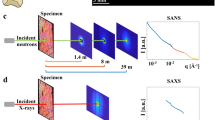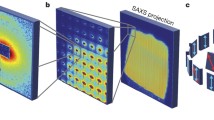Abstract.
Scanning small-angle X-ray scattering (scanning SAXS) was applied for the first time on bone to compare results from SAXS directly with those from other position-sensitive methods, such as light and polarized light microscopy, back-scattered electron imaging, and radiographic imaging. Since scanning SAXS is a nondestructive method of investigation, images from all these techniques could be obtained from the same bone sections. Thus, it could be shown that both the collagen and the mineral crystals were predominantly aligned parallel to the trabeculae and, therefore, to principle stress directions. Moreover, the mean crystal thickness as determined by scanning SAXS was found to be different at various positions inside the trabecular and cortical structure. Finally, it could be shown that scanning SAXS is suitable for detecting local changes in bone material, e.g., due to fluoride treatment.
Similar content being viewed by others
Author information
Authors and Affiliations
Additional information
Received: 12 August 1997 / Accepted: 9 July 1998
Rights and permissions
About this article
Cite this article
Rinnerthaler, S., Roschger, P., Jakob, H. et al. Scanning Small Angle X-ray Scattering Analysis of Human Bone Sections. Calcif Tissue Int 64, 422–429 (1999). https://doi.org/10.1007/PL00005824
Issue Date:
DOI: https://doi.org/10.1007/PL00005824




